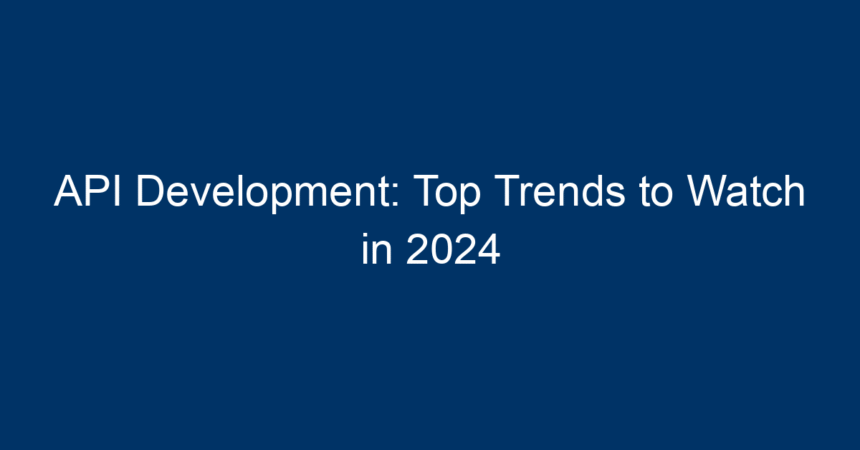In the fast-paced landscape of technology, API development stands as a cornerstone, enabling seamless integration between applications and driving innovation across industries. As we approach 2024, businesses and developers must stay attuned to the latest trends shaping the API landscape. This article discusses the top trends in API development, providing insights that will help you stay ahead of the curve.
Understanding API Development
API (Application Programming Interface) development is the process of designing and creating interfaces that allow different software applications to communicate with one another. APIs are integral to enabling functionality, enhancing user experiences, and supporting the growing ecosystem of interconnected services. As digital transformation accelerates, the importance of robust and flexible API development cannot be overstated.
Trend 1: Rise of GraphQL APIs
What is GraphQL?
GraphQL is an open-source data query language for APIs, developed by Facebook. Unlike RESTful APIs, which require multiple requests to different endpoints to gather data, GraphQL allows developers to request precisely the data they need in a single request. This flexibility is increasingly appealing to developers seeking to create efficient and responsive applications.
Why GraphQL is Gaining Traction
- Optimized Data Retrieval: With GraphQL, clients can specify their data requirements, reducing over-fetching and under-fetching issues.
- Strongly Typed Schema: The schema promotes clear expectations and better documentation, enhancing collaboration between team members.
- Rapid Development: Developers can iterate faster, as changes to the API do not necessitate changing the client codebase.
Prospects for 2024
Expect more companies to adopt GraphQL APIs as they seek streamlined data handling and improved performance. Many startups are already building their offerings around GraphQL, which points to significant momentum for the upcoming year.
Trend 2: API Security Innovations
As API usage grows, so does the potential for attacks. In 2023, API security became a critical concern, and this trend is only expected to deepen in 2024. With the rise of cyber threats, organizations must prioritize securing their APIs.
Key Security Considerations
- OAuth and OpenID Connect: Leveraging these protocols enhances authentication and authorization processes, ensuring that only authorized users access sensitive data.
- Rate Limiting and Throttling: Implementing these techniques can prevent abuse and mitigate Denial-of-Service (DoS) attacks.
- API Gateways: These serve as a protective layer for APIs, offering monitoring, rate limiting, and more.
Future Implications
In 2024, we anticipate a surge in security-focused API development solutions. Businesses will invest in tools that facilitate ongoing vulnerability assessments and incident response, making security a built-in feature of the development lifecycle.
Trend 3: Microservices Architecture
Microservices architecture divides applications into smaller, manageable services, each focused on specific business capabilities. This design pattern is becoming increasingly popular for API development, especially in enterprise environments.
Benefits of Microservices for APIs
- Scalability: Individual services can be scaled independently based on demand, optimizing resource use.
- Enhanced Flexibility: Teams can develop, test, and deploy services independently, leading to faster release cycles and better product quality.
- Improved Maintenance: Smaller codebases are easier to manage, troubleshoot, and update without altering the entire system.
The Outlook for 2024
In 2024, companies are likely to continue adopting microservices for their API development needs. The focus will be on orchestration tools and service meshes to manage the complexities that arise with microservices.
Trend 4: Low-Code and No-Code API Development
Low-code and no-code platforms are revolutionizing the API development landscape by allowing users to create APIs without extensive coding skills. This democratization of API development enables business users and citizen developers to contribute directly to application design.
Advantages of Low-Code/No-Code Solutions
- Accessibility: Non-technical users can create and manage APIs, reducing dependency on IT teams.
- Speed: Rapid prototyping and deployment lead to faster go-to-market strategies.
- Cost-Effective: Businesses can save on resources by minimizing the need for specialized developer skills.
Looking Forward to 2024
In the coming year, expect to see more robust low-code and no-code platforms making their way into mainstream adoption. Companies that invest in these solutions can accelerate their development cycles, allowing them to respond agilely to changing market demands.
Trend 5: API-First Development Approach
An API-first development approach prioritizes API design and development at the outset of a project. This methodology shifts the focus from application development to API creation, ensuring robust integration and interoperability between various components.
Key Benefits of API-First Development
- Consistent Experience: Uniform API design enhances user experience across different platforms and devices.
- Collaboration: Encourages cross-functional teams to work together, resulting in more cohesive development processes.
- Future-Proofing: APIs designed with an API-first mindset are generally more adaptable to future changes in technology and market demands.
2024 Predictions
As organizations continue to emphasize agility and scalability, the API-first approach will gain traction. Developers will increasingly use tools that support this methodology, such as API design platforms and automated documentation generators.
Conclusion: Embracing the Future of API Development
As we delve into 2024, staying ahead of these trends is crucial for organizations looking to leverage the full potential of API development. From adopting GraphQL and enhancing security measures to embracing low-code solutions and API-first strategies, the landscape is rich with opportunities for innovation.
Actionable Insights
- Invest in Training: Equip your development team with the latest tools and knowledge in GraphQL and microservices.
- Prioritize Security: Implement robust security protocols to protect your APIs from evolving threats.
- Explore Low-Code Platforms: Evaluate low-code and no-code tools for agile API development and integration.
- Shift to API-First: Consider adopting an API-first approach to ensure clarity and efficiency in your development process.
In summary, the future of API development is bright, and those who adapt to these trends will not only enhance their application ecosystems but also drive greater business value. Start preparing today for the innovations of tomorrow!




